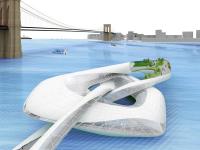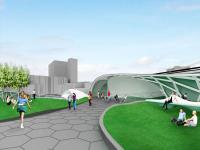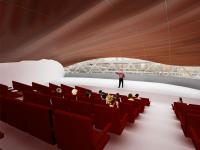As the Seamen’s Church Institute developed important roots
in the maritime worker’s world, South Street Seaport had
become a focus point in the lower Manhattan. Because of
the neighborhoods’ rapid changing and growing rate, the
urban edge condition is blurred, and can be defined in an
unconventional way. Here we propose a “no boundary”
condition in the way in which that there is no real physical
edge to the artificial land. Thus, we can break out from the
typical bar like piers.
The idea of using a mathematical knot begins with a simple
3-fold loop. By introducing the loop on the site, the spaces
become instantly more connective, because of the
continuation of the circulation and space. Hence, pedestrian
can avoid the rapidly increasing traffic on grade and take
the pedestrian bridge from Water Street. This solution relates
to the site in terms of fluidity, complexity, and flexibility. The
design of the loop connects all the programs 3 dimensionally,
as the pedestrians walk on the path. It offers a completely
different experience to each user, and appreciates the site,
the Brooklyn Bridge, and the East river simultaneously. The
internal loop naturally shapes the openings and draws natural
light down to the center of the site to conserve day time
energy use, and a large water collector is proposed for
sustainability concerns. This no boundary pavilion emerges
from the edge of Manhattan and welcomes people from its
neighborhood.
2007
2007


.jpg)
.jpg)


.jpg)

